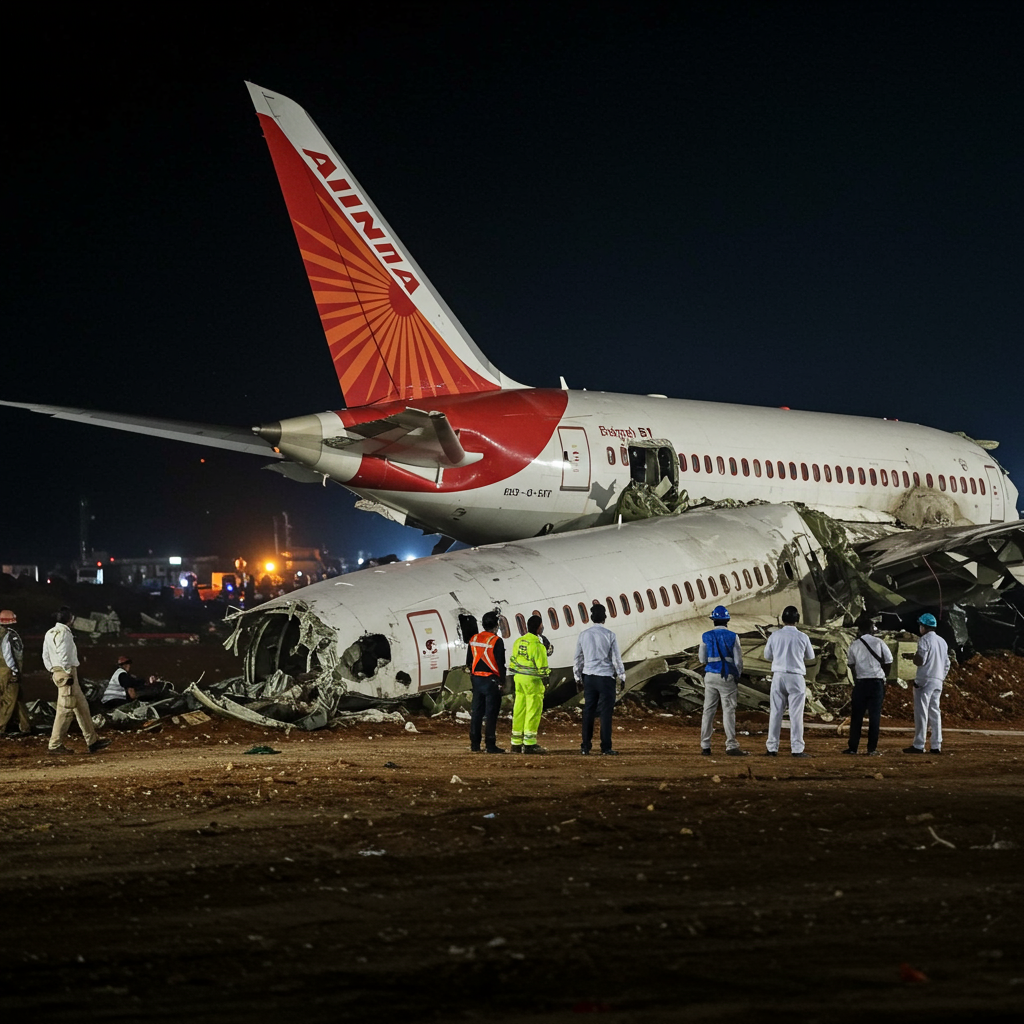The tragic crash of Air India Flight AI-171 in Ahmedabad on June 12, 2025, which claimed hundreds of lives, immediately reignited critical questions about aircraft safety. This disaster, involving a boeing 787-8 Dreamliner, quickly became linked in public discourse to a broader, more troubling narrative surrounding manufacturer Boeing. For many, the incident underscored concerns about what US regulatory and judicial findings have previously described as systemic failures, corporate obfuscation, and a perceived lack of accountability spanning years within the aviation giant. The Ahmedabad crash, in this context, appears less as an isolated mechanical failure and more as a stark, devastating symptom of a deeper, unresolved pattern.
The Ahmedabad Tragedy and Its Immediate Aftermath
Just minutes after departing Ahmedabad bound for London Gatwick, Air India Flight AI-171 plunged into a hostel complex. The crash resulted in the deaths of 241 passengers and crew onboard and at least 19 people on the ground. Eyewitness accounts described a sudden loss of altitude and smoke prior to impact. This incident marked the first fatal hull loss for the Boeing 787 Dreamliner fleet, an aircraft widely marketed for its advanced technology and safety. The sheer scale of the loss and the involvement of a modern jet prompted immediate global scrutiny, focusing attention squarely on both the operating airline, Air India, and the manufacturer, Boeing.
A Troubling Pattern Emerges
The Air India crash did not occur in a vacuum. It unfolded against a backdrop of several recent, high-profile incidents involving Boeing aircraft. Notably, it was the third mass-fatality crash involving a Boeing jet within a seven-year span, following the two catastrophic crashes of the Boeing 737 MAX aircraft. Lion Air Flight 610 crashed in Indonesia in October 2018 (189 fatalities), and Ethiopian Airlines Flight 302 crashed in Ethiopia in March 2019 (157 fatalities).
These MAX crashes exposed critical flaws related to a flight control system called MCAS. Beyond the MAX incidents, recent years have seen other concerning events, including an Alaska Airlines 737 MAX-9 losing a door plug mid-flight in January 2024, revealing manufacturing quality issues. While accident investigations are complex and often involve multiple factors, the recurrence of serious incidents involving different Boeing models has led many experts and the public alike to question whether systemic issues are at play within the company.
At the Core: Boeing’s Safety Culture and Concealment History
Investigations and legal proceedings related to the 737 MAX crashes brought to light alarming details about Boeing’s corporate practices. US Department of Justice (DOJ) findings and internal communications disclosed evidence suggesting deliberate concealment of information about the MCAS system from pilots, airlines, and regulators like the Federal Aviation Administration (FAA).
The MCAS Scandal and Lack of Transparency
The Manoeuvring Characteristics Augmentation System (MCAS) was designed to prevent stalls but relied on data from a single angle-of-attack sensor. If this sensor provided faulty data, MCAS could repeatedly force the plane’s nose down. Crucially, pilots involved in the crashes reported they were unaware of MCAS and lacked training on how to counteract or disable the system in an emergency. DOJ filings revealed that Boeing employees allegedly removed references to MCAS from training materials and misrepresented its function to the FAA. An internal email from 2017 even instructed, “delete MCAS, recall we decided we weren’t going to cover it.”
Legal Battles and Accountability Questions
These omissions formed the basis for a DOJ criminal charge against Boeing for conspiracy to defraud the United States. In January 2021, Boeing entered a Deferred Prosecution Agreement (DPA), agreeing to significant financial penalties totaling over $2.5 billion and committing to implementing a comprehensive compliance and ethics program. However, in May 2024, the DOJ determined Boeing had violated the DPA terms by failing to prevent fraud, potentially opening the door for renewed prosecution.
While Boeing subsequently reached an agreement in principle for a new Non-Prosecution Agreement (NPA), this deal faced judicial scrutiny and victim consultation requirements. Despite Boeing admitting to the facts of its past conduct, as of mid-2025, court orders had vacated a previously scheduled trial, effectively allowing the company to avoid facing a jury on criminal charges, provided the new NPA is approved. A key point of contention and public concern remains the fact that no individual Boeing executive has been prosecuted in relation to the admitted misconduct, raising questions about accountability at the highest levels.
The Dreamliner Under Scrutiny
The Ahmedabad crash specifically involved a Boeing 787 Dreamliner, bringing renewed attention to this particular model. While initially heralded for its technological advancements, the 787 program has faced its share of challenges and scrutiny.
Production Issues and Whistleblower Warnings
Over the years, the 787 has encountered various production flaws, including issues with fuselage joins and electrical grounding, which led the FAA to halt deliveries multiple times between 2021 and 2023. More disturbingly, these issues have been highlighted by whistleblowers. John Barnett, a former Boeing quality manager at the 787 production plant, raised alarms about defective oxygen systems and workers allegedly installing rejected parts. Another engineer, Sam Salehpour, alleged workers used excessive force (“jumped on”) to fit misaligned fuselage parts, potentially compromising long-term structural integrity. These serious allegations were made public before the Ahmedabad crash.
A 2024 internal survey at a Boeing plant reportedly found that a significant number of workers expressed reluctance to fly on the 787 themselves, citing concerns about rushed assembly and quality control. Furthermore, in 2024, Boeing admitted that counterfeit titanium with falsified documents had been used in some 787 and 777 jets, adding another layer of concern about supply chain integrity and quality assurance. The Ahmedabad crash now tragically underscores the potential real-world consequences if these reported production and quality issues were indeed present on the accident aircraft.
Regulatory Oversight and Public Trust
The pattern of incidents and the documented history of concealment raise critical questions about the effectiveness of regulatory oversight. US findings have pointed to a “systemic failure” that enabled corporate misconduct. Critics argue that regulators like the FAA have historically been too lenient, perhaps relying too heavily on Boeing’s own internal processes (self-certification). This perceived lack of robust, independent oversight is seen by many as a contributing factor to ongoing safety concerns.
In India, the Directorate General of Civil Aviation (DGCA) is involved in the Ahmedabad crash investigation, highlighting the global nature of aviation safety regulation and its challenges. The cumulative effect of repeated safety incidents and questions about corporate honesty has undeniably eroded public trust in both Boeing as a manufacturer and the regulatory institutions responsible for ensuring air travel safety worldwide.
Air India’s Operational Context
While Boeing faces intense scrutiny, the investigation into the Air India Flight AI-171 crash will also examine factors related to the airline itself. Air India has been undergoing a significant transformation under its new ownership, including ambitious expansion plans. This rapid growth has reportedly put strain on internal systems, potentially affecting maintenance schedules, parts sourcing, and staff readiness. Questions may arise regarding whether the specific aircraft was properly maintained, if pilots received adequate training on the Dreamliner’s complex systems and emergency procedures, or if operational pressures played a role. Air India also has a history of fatal incidents over the decades, adding another layer of complexity to the investigation. Ultimately, major aviation accidents often result from a “convergence of failures” across multiple domains – design, manufacturing, maintenance, operations, and oversight.
The Path Forward: Investigations and Calls for Reform
Investigations into the Air India Flight AI-171 crash by Indian authorities, with assistance from Boeing and international experts, are critical to determining the specific technical and human factors involved. The findings will be closely watched by global regulators like EASA and the FAA. This tragedy is likely to intensify existing calls for stricter oversight of Boeing and the broader aviation manufacturing industry. Victims’ families are expected to pursue legal action against both Air India and Boeing. The focus is now on demanding greater transparency, reinforcing maintenance standards, and ensuring that safety principles are unequivocally prioritized over production speed or financial targets across the entire aviation ecosystem. Rebuilding confidence in air travel requires a demonstrated commitment from manufacturers, airlines, and regulators to uphold the highest standards of safety and accountability.
Frequently Asked Questions
What specific safety issues and allegations have been raised against Boeing’s aircraft?
Boeing has faced allegations of deliberate concealment related to the 737 MAX’s MCAS system, including removing information from pilot manuals. For the 787 Dreamliner, issues include production flaws like fuselage join problems and the use of counterfeit titanium. Whistleblowers have also alleged defective oxygen systems, use of scrap parts, disregard for safety checks, and rushing production, leading some employees to express reluctance to fly on the 787.
What is the current legal status of the US Department of Justice case against Boeing regarding past conduct?
The US Department of Justice found Boeing violated a 2021 Deferred Prosecution Agreement (DPA) related to the 737 MAX crashes. While a new Non-Prosecution Agreement (NPA) has been proposed involving additional penalties, it remains under judicial review. Court orders in June 2025 vacated the previously scheduled criminal trial against Boeing, indicating the company is likely to avoid trial provided the new NPA is approved, despite admitting to the facts of its past misconduct.
How has the Air India crash and Boeing’s history impacted confidence in global air safety?
The Air India Flight AI-171 crash, following a series of incidents involving Boeing aircraft and against a history of documented issues and regulatory leniency, has significantly eroded public trust. Experts point to a broken system where corporate priorities may overshadow safety. The crash is a stark reminder of the potential consequences of manufacturing defects and oversight gaps, prompting intensified investigations and calls for stricter global regulation and greater accountability within the industry to restore confidence.
Conclusion
The crash of Air India Flight AI-171 stands as a tragic reminder of the immense human cost when complex systems fail. While the official investigation will pinpoint the immediate causes, the incident resonates deeply because it appears linked to a pattern of historical issues surrounding one of the world’s largest aircraft manufacturers. The details revealed about Boeing’s past conduct, from MCAS concealment on the 737 MAX to production concerns and whistleblower allegations on the 787 Dreamliner, fuel public anxiety and demand accountability. The path forward requires not only thorough accident investigations but also a fundamental re-evaluation of manufacturing quality control, regulatory effectiveness, and the corporate culture within the aviation industry to ensure that safety truly comes first, always.




